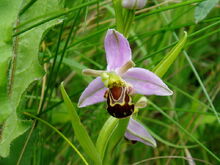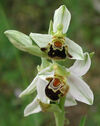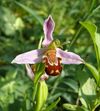| Ophrys apifera | |||||||||||||||||
|---|---|---|---|---|---|---|---|---|---|---|---|---|---|---|---|---|---|
| |||||||||||||||||
Ophrys apifera (Bee Orchid) is a plant of the family Orchidaceae, found in western and central Europe, the Mediterranean region, and east through Turkey to the Caucasus.
Distribution[]
Ophrys apifera is a perennial, temperate climate species of orchid generally found growing on semi-dry turf, on limestone, calcareous dunes or in open areas in woodland, from sea level up to around 1800 metres in elevation. The Bee Orchid is a common plant around the Mediterranean eastwards to the Black Sea but is less common in its northern range being uncommon or local in Germany and Ireland. In the UK it has a distinct southern preference being more common in southern England, but spreading north in recent decades with colonisation of Northumberland (often on old mine spoil heaps and other semi-reclaimed industrial sites) and also one site in southern Scotland. In some countries the plants have protected status. The Bee Orchid is the county flower of Bedfordshire.
Description[]
They are unusual in that in some years they appear in great numbers, then sometimes only reappear after an absence of many years. This hardy orchid grows to a height of 30 cm. They live in a symbiotic relationship with mycorrhiza (a soil-dwelling fungus).
The Bee Orchid develops small rosettes of leaves in autumn. They slowly continue to grow during winter. The leaves are alternate, elliptical and pointed. Flowers appear the following year. Each year, it produces from one to ten flowers on a spike, blooming from June to July. The flowers are almost exclusively self-pollinating in the northern ranges of the plant's distribution, while pollination by the solitary bee Eucera occurs in the Mediterranean area. The sepals are marginal and spread out, coloured mauve to pink, often with a greenish central line. The flower lip is furry to the touch and is quite variable in the pattern of coloration, but is usually brownish-red with yellow markings.
The pollinia are produced on the inner face of a greenish column overhanging the lip, ready to deposit the pollen on visiting bees. Eucera bees in the past have influenced the evolution of bee orchids. Male bees, over many generations of cumulative orchid evolution, have favoured plants with the most female-bee-shaped lip through trying to copulate with flowers, and hence carrying pollen.
Culture[]
Plants prefer well-drained low-fertility soils and areas with partial shade. Plants are very sensitive to the addition of fertilizers or fungicides and transplanting because it kills symbiotic fungus. The plant is usually propagated through seed culture. This species is tolerant of cool but not cold growing conditions. Divide plant when flower fades.
Varities[]
Naming[]
Common Name: Bee orchid, The Bee Ophyrs
Synonyms[]
- Arachnites apifera Tod. 1791
- Ophrys albiflora Spruner ex Boiss 1882
- Ophrys apifera f. flavescens (Rosbach) P.D.Sell in P.D.Sell & G.Murrell 1996
- Ophrys apifera f. trollii (Hegetschw.) P.D.Sell in P.D.Sell & G.Murrell 1996
- Ophrys apifera subsp. austriaca (Wiesb. ex Dichtl) K.Richt 1890
- Ophrys apifera subsp. chlorantha (Hegetschw.) Arcang 1882
- Ophrys apifera subsp. trollii (Hegetschw.) O.Bolòs 1991
- Ophrys apifera var. almaracensis Pérez-Chisc 1990 publ. 1991
- Ophrys apifera var. aurita (Moggr.) Gremli 1887
- Ophrys apifera var. basiliensis S.Schwegler & Matthies 2004
- Ophrys apifera var. belgarum Turner Ettl 1998
- Ophrys apifera var. chlorantha (Hegetschw.) K.Richt 1890
- Ophrys apifera var. flavescens Rosbach 1880
- Ophrys apifera var. fulvofusca M.P.Grasso & Scrugli 1987
- Ophrys apifera var. immaculata Bréb 1849
- Ophrys apifera var. muteliae Mutel 1835
- Ophrys apifera var. tilaventina Nonis & Liverani 1997
- Ophrys apifera var. trollii (Hegetschw.) Rchb.f. 1851
- Ophrys aquisgranensis Kaltenb 1850
- Ophrys arachnites Mill. 1768
- Ophrys austriaca Wiesb. ex Dichtl 1883
- Ophrys chlorantha Hegetschw 1840
- Ophrys epeirophora Peter 1883
- Ophrys immaculata (Bréb.) O.Nägeli 1916
- Ophrys insectifera L. in part 1753
- Ophrys insectifera subvar. aurita Moggr. 1869
- Ophrys penedensis Kalkhoff 1914
- Ophrys purpurea Tausch 1831
- Ophrys ripaensis Porta 1905
- Ophrys rostrata Ten. 1830
- Ophrys trollii Hegetschw. 1840
- Orchis apifera (Huds.) Salisb. 1796;
References[]
- The Euro+Med PlantBase
- Online Atlas of the British and Irish flora
- Swan, G. A. (1993). Flora of Northumberland. ISBN 0 9520782 0 1









